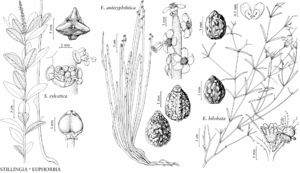Euphorbia bilobata
Rep. U.S. Mex. Bound. 2(1): 190. 1859.
Herbs, annual, with slender taproot. Stems erect, branched, 10–35 cm, glabrous or strigillose (especially when young and around nodes). Leaves opposite proximally, alternate distally; stipules 0.1–0.2 mm; petiole 1–4 (–6) mm, glabrous, sericeous or strigillose; blade linear to narrowly elliptic, 8–52 × 2–7 mm, base attenuate, margins entire, ciliate-strigose, apex acute, abaxial surface sparsely strigillose to sericeous, adaxial surface usually glabrous; venation obscure, only midvein conspicuous. Cyathia solitary at distal nodes or in weakly defined cymes or dichasia, dichasial bracts and distal stem-leaves wholly green; peduncle 0.5–3.6 mm, strigillose. Involucre obconic, 0.9–1.5 × 0.9–1.3 mm, strigillose to pilose; glands 5, yellow or pink, U-shaped, 0.2–0.3 × 0.4–0.5 mm; appendages greenish, white, or pink, forming narrow rim around gland, or ovate, oblong, or obovate and usually 2-fid, rarely rudimentary, 0.2–1.4 × 0.2–0.6 mm, entire. Staminate flowers 20–25. Pistillate flowers: ovary glabrous, puberulent, strigillose, or pilose; styles 0.5–0.8 mm, 2-fid 1/3–1/2 length. Capsules oblate, 1.5–2.6 × 2.1–3.3 mm, glabrous or puberulent, strigillose, or pilose; columella 1.2–2.1 mm. Seeds brown to grayish black, narrowly ovoid, 3-angled or 4-angled in cross-section, sometimes obscurely so, 1.3–1.9 × 1–1.4 mm, tuberculate, often with shallow depressions; caruncle absent. 2n = 32.
Phenology: Flowering and fruiting spring–fall.
Habitat: Sandy and rocky soils on slopes and canyon bottoms in pine-juniper woodlands, oak woodlands, grasslands.
Elevation: 1400–2600 m.
Distribution

Ariz., N.Mex., Tex., Mexico (Chihuahua), Mexico (Durango), Mexico (Sonora)
Discussion
In Texas, Euphorbia bilobata is known only from Jeff Davis County.
Selected References
None.
Lower Taxa
"connate" is not a number. "distinct" is not a number."/3" is not declared as a valid unit of measurement for this property. "/2" is not declared as a valid unit of measurement for this property.
